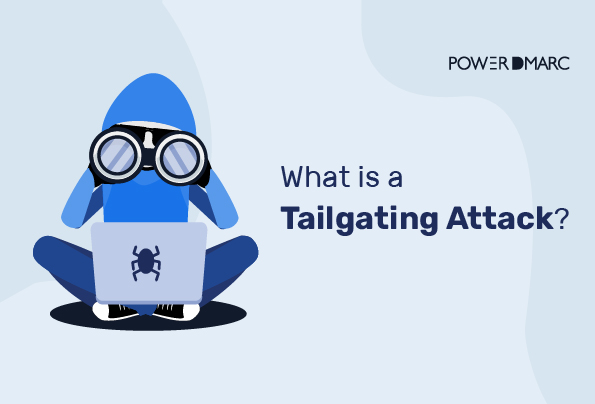A “tailgating attack” is a form of social engineering that emphasizes physical elements over virtual ones. Tailgating is essentially a social engineering attack in which the attacker follows a legitimate individual into a prohibited area where they are not allowed to be. People frequently picture nefarious cybercriminals acting from afar when considering data breaches. However, allowing someone without authorization to enter your property, possibly through a tailgating attack, puts businesses in danger of having their confidential or sensitive information leaked.
Most cyberattacks are the result of social engineering risks. According to research, these attacks are becoming increasingly frequent, with 989,000 unique phishing attacks detected worldwide in 2024.
Most people can recognize a straightforward phishing scam. But can you or your coworker spot tailgating?
Let’s dive in to learn what is a tailgating attack and how you can prevent it yourself.
Key Takeaways
- Tailgating is a social engineering attack that involves unauthorized individuals gaining access to secured areas by following authorized personnel.
- Most cyberattacks, including tailgating, are rooted in social engineering tactics, often exploiting human trust and awareness.
- Employees should be educated on security protocols to prevent tailgating and understand the importance of verifying credentials.
- Implementing physical security measures like locks, alarms, and surveillance cameras helps deter tailgating attempts.
- Visitor credentials should be established to restrict access to sensitive areas, allowing entry only under controlled circumstances.
What Is a Tailgating Attack?
A tailgating attack in cybersecurity refers to a physical security breach where an unauthorized individual gains access to a secure area or system by following an authorized person, often without being noticed. While it’s a physical intrusion, it poses serious cybersecurity risks, such as unauthorized access to computers, servers, or sensitive data.
An attacker dresses like a technician and waits near the entrance of a company’s server room. When an employee with authorized access uses their badge to open the door, the attacker quickly slips in behind them, without using their own credentials. Once inside, they could plug a malicious USB drive into a networked computer, install keyloggers, or access confidential information.
Even though the attacker doesn’t hack a system digitally, their physical presence can compromise cybersecurity infrastructure.
Tailgating vs Piggybacking
Though often used interchangeably, tailgating and piggybacking can have subtle differences:
- Tailgating: The unauthorized person enters without the knowledge or consent of the authorized person. For instance, sneaking in close behind someone as the door is closing.
- Piggybacking: The unauthorized person is allowed in with the consent of the authorized individual, often due to misplaced trust or social pressure. For example, someone asks to be let in, and the authorized person agrees.
Protect From Tailgating Attacks with PowerDMARC!
What Are Common Tailgating Methods?
A standard method of tailgating cyber attacks is to impersonate an employee with similar clothing or appearance, such as wearing a uniform or carrying a backpack identical to those used by employees, and then following them through the door.
Other common methods include:
- Using a fake ID badge with similar markings as those issued by your target organization (e.g., logos). The attacker may also impersonate someone else’s badge number when speaking with security guards or receptionists;
- Using stolen credentials from another individual; and
- Using fake credentials purchased online from criminals specializing in identity theft and data breaches.
How To Prevent Tailgating?
Tailgating can be easy to prevent if you’re aware of it. Here are some tips to ensure security tailgating :
Train Your Employees
The most crucial step in preventing tailgating is educating your employees on the importance of following security procedures. Conduct regular training sessions and ensure all employees understand their role in keeping your facility safe.
Improve Physical Security
Ensure all entrances and exits are secure with good physical security measures such as locks, alarms, surveillance cameras, and guards if necessary. This will help ensure that only authorized people can access these areas of your building or campus.
Know About Social Engineering
One of the reasons why people tailgate is because they know someone who works in the company, and they think this person will let them go through without checking their credentials. This is called social engineering, and you should ensure all your employees are aware of the dangers involved. If they know that they might get fired if they let someone go through without checking their credentials, it will discourage them from doing so.
Use Security Cams
Security cameras can help deter tailgating because they’re installed at every entrance and exit of every building with an alarm system. This way, security personnel can view the footage and see who’s trying to get into the building without authorization and report it immediately so that they can stop them from entering further into the building once they’ve gained access through the front entrance or lobby area where security cams aren’t installed yet.
Visitors Credentials
A visitor’s credential allows someone access to your facility with limited privileges. For example, they may be allowed in certain areas and only in others if accompanied by an employee with proper credentials.
Final Words
Tailgating attacks may seem low-tech, but they pose a high risk to your organization’s cybersecurity. By exploiting human trust and physical access, attackers can bypass digital defenses and compromise sensitive data. Educating employees, enhancing physical security, and maintaining vigilance are crucial to preventing these threats.
Looking to fortify your cybersecurity from all angles? PowerDMARC helps protect your digital assets with advanced email authentication solutions that complement your physical security efforts. Get started with PowerDMARC today and take control of your cybersecurity.
- What Is SMS Spoofing? Definition, Examples & Risks - July 21, 2025
- What Are Datacenter Proxies? Definition, Uses & Benefits - July 21, 2025
- What Is a Tailgating Attack in Cybersecurity? - July 19, 2025
